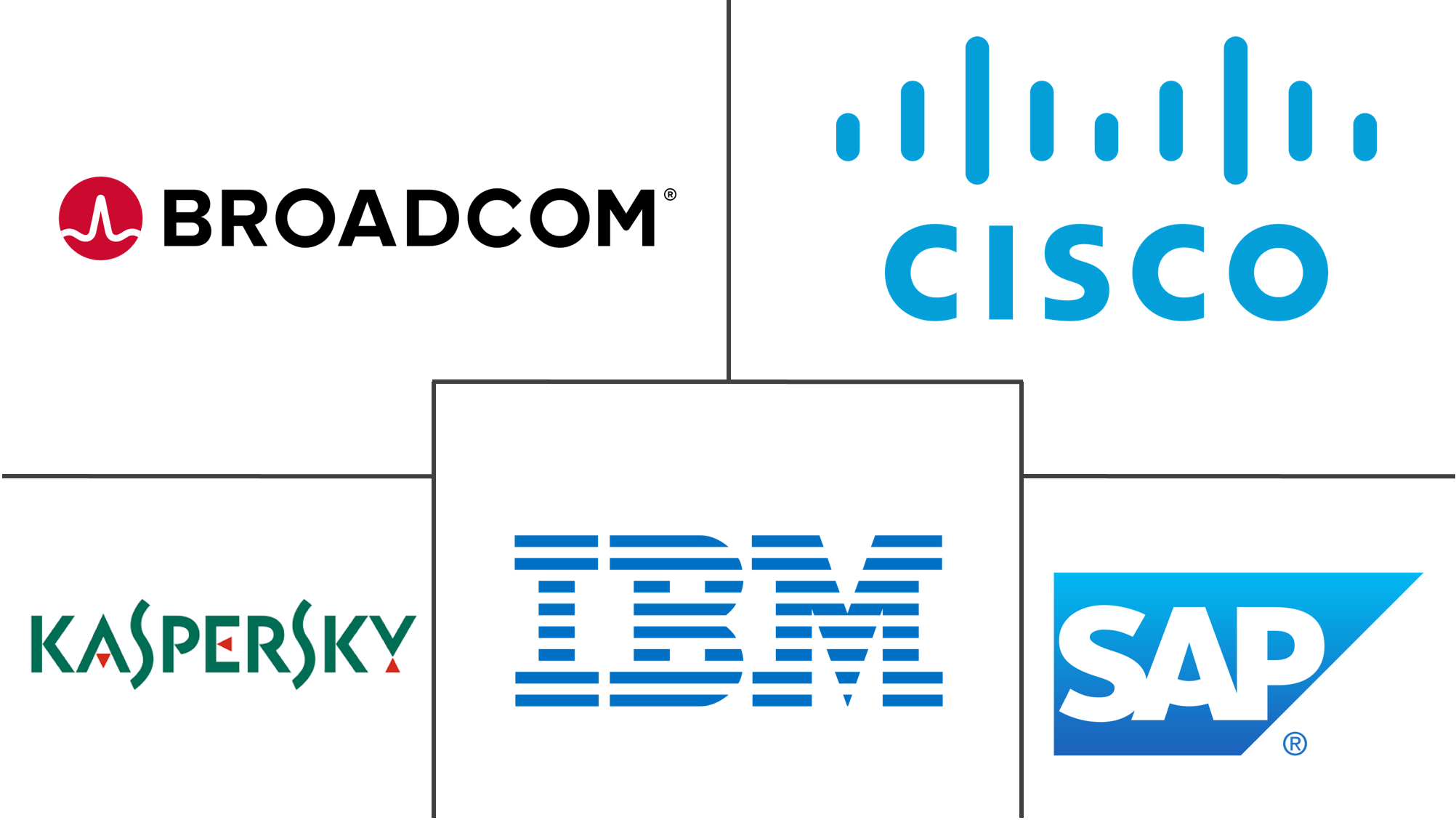Mobile Device Management Market Size and Share
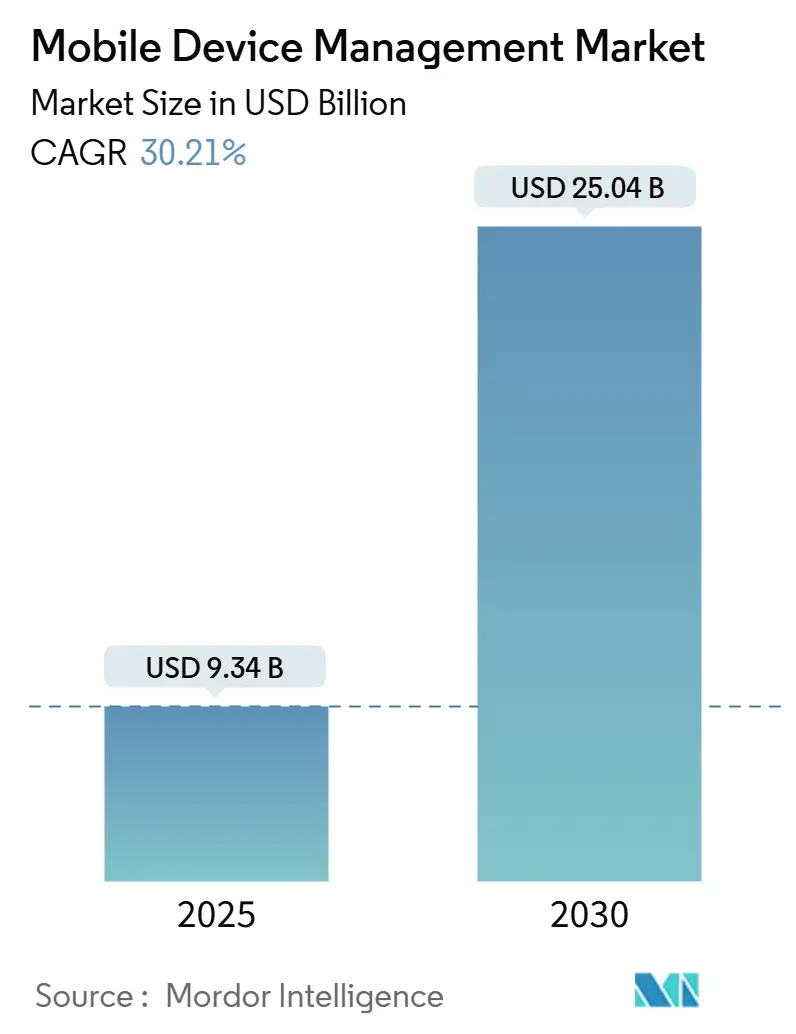
Mobile Device Management Market Analysis by Mordor Intelligence
The mobile device management market size reached USD 9.34 billion in 2025 and is projected to reach USD 25.04 billion in 2030, progressing at a 30.21% CAGR through the forecast period. Surging enterprise mobility-first strategies, rising bring-your-own-device (BYOD) expectations, and post-quantum security preparations collectively accelerate adoption. Cyber-insurance carriers now require proof of endpoint control before underwriting policies, which elevates mobile device management from discretionary spend to operational necessity. A widening gap between cloud-native unified endpoint management (UEM) platforms and legacy on-premise stacks is reshaping vendor positioning. Meanwhile, 5G-enabled field-service expansion and escalating IoT deployments are enlarging the addressable device base, amplifying total contract value for vendors. Competitive intensity is rising as Microsoft, Broadcom-Omnissa, and Jamf consolidate capabilities while niche specialists chase industrial and quantum-safe opportunities.
Key Report Takeaways
- By deployment mode, cloud solutions held 57.5% of the mobile device management market share in 2024; hybrid deployments post the fastest CAGR at 17.6% through 2030.
- By device type, smartphones and tablets contributed 64.1% revenue in 2024, while IoT/IIoT endpoints are forecast to expand at 23.6% CAGR to 2030.
- By end-user industry, IT and telecom dominated with 27.4% revenue in 2024; healthcare and life sciences advance at 16.5% CAGR through 2030.
- By ownership model, corporate-owned devices held 54.3% share of the mobile device management market size in 2024, whereas BYOD policies rise at 22.3% CAGR.
- By geography, North America led with 39.5% of the mobile device management market share in 2024; Asia-Pacific records the fastest 17.7% CAGR to 2030.
Global Mobile Device Management Market Trends and Insights
Drivers Impact Analysis
| Driver | ( ~ ) % Impact on CAGR Forecast | Geographic Relevance | Impact Timeline |
|---|---|---|---|
| Explosion of enterprise BYOD policies | +8.2% | Global, concentrated in North America and Europe | Short term (≤ 2 years) |
| Accelerating shift to cloud-native UEM suites | +7.5% | Global, led by North America, expanding to Asia-Pacific | Medium term (2-4 years) |
| Surge in cyber-insurance mandates | +5.8% | North America and EU, spreading to Asia-Pacific financial hubs | Short term (≤ 2 years) |
| 5G-enabled field-service workforce expansion | +4.9% | Asia-Pacific core, spill-over to North America and MEA | Medium term (2-4 years) |
| Post-quantum security preparations | +3.1% | Global, early in government and financial sectors | Long term (≥ 4 years) |
| ESG-linked procurement | +2.7% | EU and North America, emerging in Asia-Pacific | Long term (≥ 4 years) |
| Source: Mordor Intelligence | |||
Explosion of enterprise BYOD policies
Employee expectations have shifted sharply, with 87% of workers anticipating the option to use personal devices for professional tasks. Organizations cite 33% device-procurement savings and productivity gains when BYOD programs are deployed. These advantages heighten demand for data-segregating containers and user-centric experience tuning. Yet, 61% of employees admit bypassing security safeguards when tools seem cumbersome. This tension forces vendors to rethink identity, privacy, and user-experience design, propelling innovation across the mobile device management market.
Accelerating shift to cloud-native UEM suites
Cloud-first UEM deployments deliver 40% lower total cost of ownership than on-premise alternatives. Microsoft Intune already commands 23.4% market share by embedding endpoint security controls inside Microsoft 365 environments. Enterprises cut management overhead by 60% and enforce security patches faster, a valuable benefit for geographically dispersed workforces that persist post-pandemic. This momentum widens the competitive gap for vendors still tethered to data-center architectures.
Surge in cyber-insurance mandates for endpoint control
Underwriters now list specific mobile security capabilities—multifactor authentication, encryption, real-time detection—as prerequisites for coverage[2]CRC Group, “Cyber Insurance Endpoint Security Requirements,” crcgroup.com. Companies lacking compliant endpoint oversight face 20–30% premium hikes or outright denial. The immediate financial incentive clarifies ROI for adopting enterprise-grade mobile device management, especially among small and mid-sized employers. This requirement anchors cyber insurance as a structural growth lever in the mobile device management market.
5G-enabled field-service workforce expansion
Seventy percent of field-service organizations cite 5G as a primary investment catalyst. Real-time video support, augmented-reality troubleshooting, and predictive maintenance depend on rugged mobile endpoints. Manufacturers signing 5G-rugged deployments reclaim USD 2 million annually in avoided downtime. Managing these devices in harsh environments elevates the value of resilient, low-touch MDM capabilities, expanding the mobile device management market footprint into operational technology.
Restraint Impact Analysis
| Restraint | ( ~ ) % Impact on CAGR Forecast | Geographic Relevance | Impact Timeline |
|---|---|---|---|
| front integration cost with legacy IAM/ITSM | -4.3% | Global, mid-market enterprises most affected | Short term (≤ 2 years) |
| Fragmented regulatory data-sovereignty rules | -3.7% | EU and Asia-Pacific, emerging complexity in MEA | Medium term (2-4 years) |
| Growing employee privacy push-back | -2.9% | North America and EU, expanding to Asia-Pacific | Short term (≤ 2 years) |
| Limited battery/CPU headroom on rugged IoT | -2.1% | Industrial sectors globally | Long term (≥ 4 years) |
| Source: Mordor Intelligence | |||
Up-front integration cost with legacy IAM/ITSM stacks
Enterprises report annual integration outlays exceeding USD 73,000 when aligning modern UEM platforms with incumbent identity and service-management systems. Multiple authentication providers deepen complexity, often doubling roll-out timelines. Mid-market firms lacking dedicated engineers face the steepest hurdle, delaying full deployment and restraining early-period revenue recognition in the mobile device management market.
Growing employee privacy push-back on device tracking
Labor advocates increasingly scrutinize continuous GPS and usage monitoring. Sixty percent of employees view pervasive surveillance as intrusive. Regulatory landscapes remain fluid, with jurisdictions weighing stricter consent mandates. Vendors now embed privacy dashboards and granular opt-out controls, extending development cycles and adding cost layers to remain compliant and trusted.
Segment Analysis
By Deployment Mode: Cloud adoption deepens operational agility
Cloud platforms accounted for 57.5% of the mobile device management market in 2024 and will grow at 17.6% CAGR to 2030. Organizations migrating to subscription models reduce infrastructure spending, accelerate policy roll-outs, and gain elastic scalability. Microsoft, VMware-Omnissa, and Google industry alliances lower entry barriers for mid-sized enterprises by bundling identity, productivity, and security. On-premise deployments persist in defense, healthcare, and government domains where data-sovereignty or air-gap mandates prevail. Hybrid frameworks serve as transitional architectures, blending local control with cloud orchestration to avoid forklift migrations. As integration toolkits mature, buyers evaluate vendors on self-service provisioning, automation depth, and analytics rather than simple device counts. These dynamics broaden the total addressable base for the mobile device management market while intensifying platform differentiation.
The mobile device management market size for cloud deployments is projected to reach USD 15.8 billion by 2030, propelled by continual software updates and shorter contracting cycles. Vendors capitalize on this momentum through consumption-based pricing that aligns with seat expansions. Conversely, on-premise license renewals contract as CFOs favor opex-led cloud budgeting. Service integrators adapt by bundling managed security and compliance audits, turning deployment flexibility into recurring consulting revenue. Strategic partnerships between hyperscale clouds and niche MDM vendors expand distribution, particularly in emerging economies where local resellers guide compliance navigation.
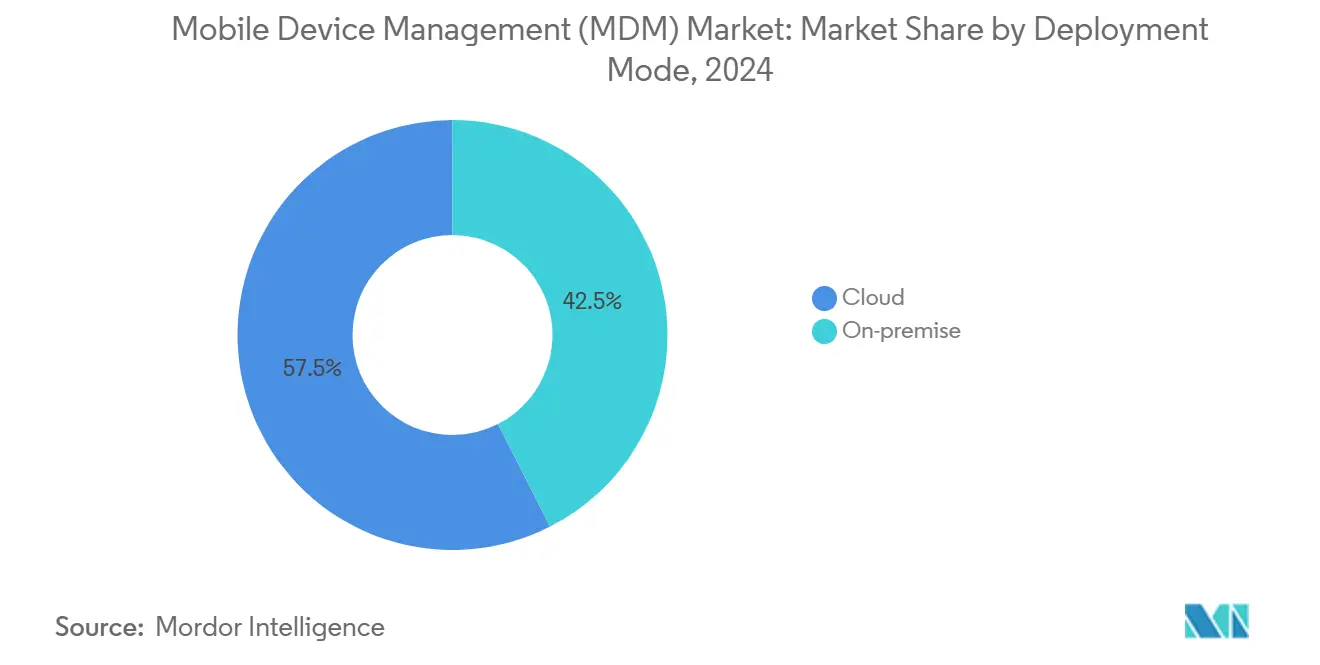
Note: Segment shares of all individual segments available upon report purchase
By Device Type: IoT endpoints redefine scale and complexity
Smartphones and tablets delivered 64.1% of 2024 revenue, underscoring their role in knowledge-worker productivity. However, industrial IoT sensors, gateways, and rugged wearables register 23.6% CAGR through 2030, dwarfing growth in mature form factors. Manufacturers, utilities, and logistics operators integrate thousands of low-power nodes, pushing device counts per enterprise into six-digit territory. Battery-constrained equipment necessitates lightweight agents that minimize compute cycles, forcing vendors to innovate beyond standard MDM stacks. The mobile device management market size attributable to IoT is forecast to exceed USD 6.4 billion by 2030, reflecting new billing metrics based on active connections rather than human users.\
Edge computing intersects with device diversity. Enterprises deploy micro data centers on factory floors, demanding local policy enforcement even during WAN disruptions. MDM platforms now embed remote firmware management, zero-touch provisioning, and AI-driven anomaly detection to maintain uptime. The expanded endpoint mix blurs boundaries between operational-technology and information-technology teams, reshaping procurement and governance models.
By End-User Industry: Healthcare claims fastest runway
IT and telecom remained the largest buyers with 27.4% revenue in 2024, using MDM for fleet standardization and security orchestration. Healthcare and life sciences lead in growth at 16.5% CAGR as telehealth, electronic health records, and remote patient monitoring amplify sensitive data flows. The mobile device management market gains momentum here by embedding HIPAA-aligned audit logs, remote wipe, and controlled kiosk modes for shared clinical tablets. BFSI institutions deepen endpoint security to satisfy PCI DSS mandates while thwarting mobile banking fraud. Manufacturers deploy rugged tablets on shop floors, integrating barcode readers and augmented-reality overlays, which require low-latency policy updates.
Education adds device lifecycle automation to support one-to-one student Chromebook and iPad initiatives, while the public sector focuses on secure citizen services. Verticalized compliance templates accelerate adoption in highly regulated spaces, enabling vendors to premium-price sector-specific modules. This specialization fuels cross-sell of managed services and analytics, enlarging the mobile device management market.
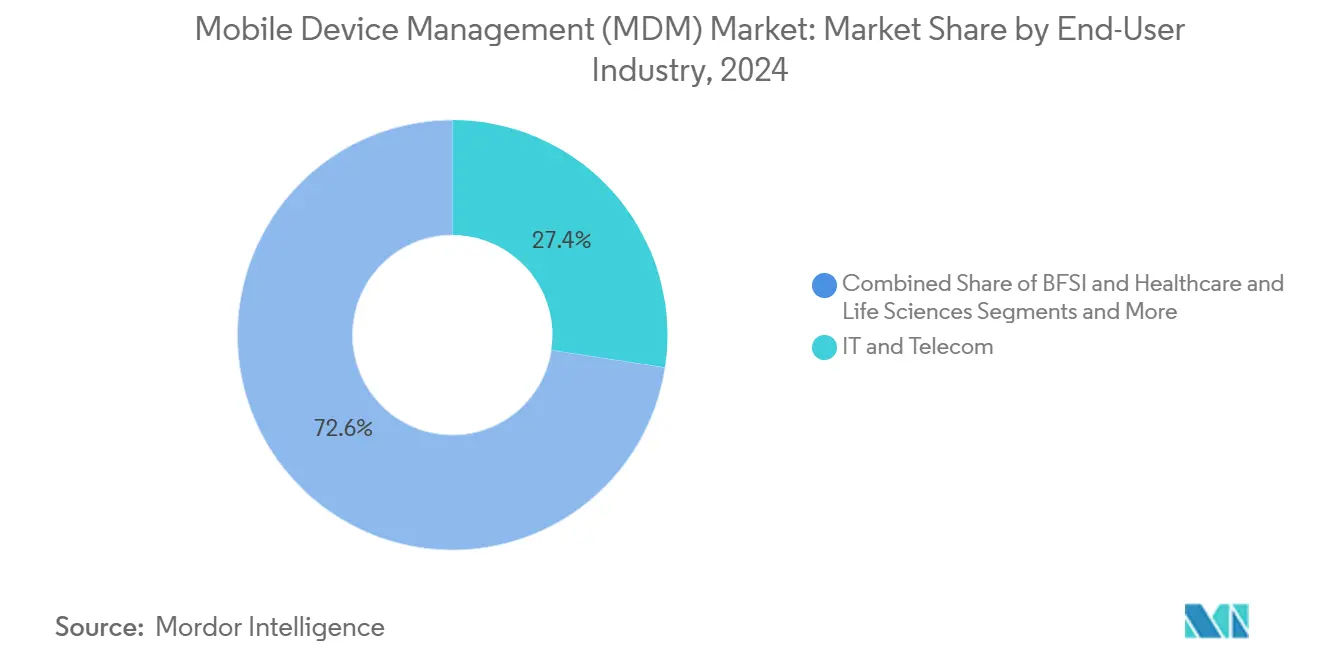
Note: Segment shares of all individual segments available upon report purchase
By Ownership Model: BYOD reshapes risk calculus
Corporate-owned fleets preserved 54.3% revenue control in 2024, yet BYOD remains the growth engine with 22.3% CAGR. Executives cite procurement savings and improved employee satisfaction but acknowledge heightened data-separation challenges. CYOD and COPE models act as compromise frameworks, allowing hardware choice inside predefined compliance envelopes. The mobile device management market responds with dual-persona workspaces, biometric gating, and privacy-aware telemetry to satisfy both IT and workers. As generational preferences favor device autonomy, enterprises adopt risk-based authentication, conditional access, and micro-segmentation to close exposure gaps.
BYOD’s expansion reshapes procurement cycles since stipend or zero-cost device models shift budgeting from CapEx to OpEx. Insurers calibrate cyber-risk premiums according to control maturity over personal devices, deepening the connection between ownership models and financial exposure. Vendors that simplify enrollment and self-service remediation stand to capture incremental share as program enrollments surge.
Geography Analysis
North America held 39.5% of the mobile device management market in 2024, supported by early smartphone adoption, stringent HIPAA and PCI DSS regulations, and a mature cyber-insurance ecosystem that requires endpoint governance. Regional enterprises integrate threat intelligence from Microsoft Defender and Jamf Threat Defense, tightening zero-trust architectures. Large healthcare systems extend MDM to remote patient-monitoring kits, while fintechs emphasize biometric authentication on consumer mobiles.
Asia-Pacific is the fastest-growing territory at 17.7% CAGR through 2030, buoyed by 5G roll-outs and government-driven Industry 4.0 incentives[1]GSMA, “The Mobile Economy Asia Pacific 2024,” gsma.com. China, South Korea, and India add hundreds of millions of enterprise-enabled devices as factories digitalize and banks promote mobile wallets. Public-sector smart-city projects in Singapore and Japan require resilient endpoint orchestration across sensors, kiosks, and field-service tablets. Country-specific data-residency laws spark demand for localized cloud regions, giving rise to regional hosting partnerships that expand the mobile device management market.
Europe registers solid momentum anchored in GDPR compliance. Enterprises must demonstrate lawful processing, explicit consent, and breach notification, turning encryption at rest and data-siloing into baseline features. ESG-linked procurement encourages selection of vendors with carbon-aware device analytics and equipment-life-cycle extensions. Automotive and aerospace manufacturers integrate MDM into shop-floor tablets to meet CE marking requirements. Fragmented regulations, however, prolong sales cycles as buyers conduct country-level legal reviews. Vendors able to package multilingual support, field-level encryption, and local professional-services reach gain share.
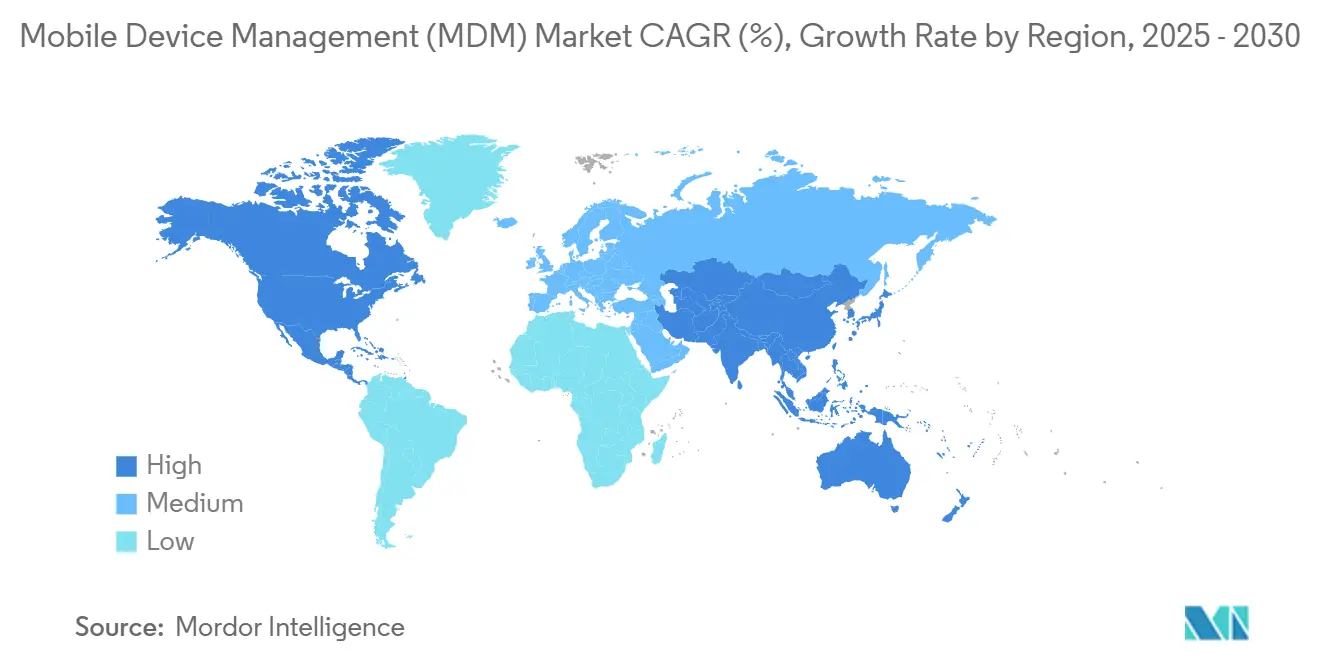
Competitive Landscape
The mobile device management market remains moderately fragmented yet converging. Top vendors focus on ecosystem breadth, integration depth, and vertical specialization. Microsoft Intune leads with 23.4% market share by tying endpoint security to Microsoft 365 licenses. Broadcom’s acquisition of VMware and the formal spin-off of Omnissa streamlines Workspace ONE under a dedicated user-experience business that generates USD 1.5 billion annual recurring revenue. Jamf dominates Apple-centric fleets with 76,600 customers and 33.9 million devices managed while expanding into identity orchestration via its USD 215 million purchase of Identity Automation.
Strategic alliances intensify. Cloud Software Group inked an eight-year pact with Microsoft to infuse Citrix’s desktop-as-a-service with Azure AI, bolstering device-compliance analytics. Samsung embedded post-quantum cryptography in the Galaxy S25 line via Knox Matrix, setting a new bar for quantum-safe mobile endpoints[3]Samsung Electronics, “Galaxy S25 Series Introduces Quantum-Safe Security,” news.samsung.com. These moves pressure rivals to fast-track quantum-ready key-management and AI-powered anomaly detection. Emerging specialists such as Esper, Mosyle, and JumpCloud court vertical niches with Android-kiosk, Apple-first, and identity-driven device governance respectively.
Pricing competition pivots away from device counts to value-based tiers incorporating threat hunting, analytics, and automated compliance evidence. Vendors package zero-trust network access, patch orchestration, and AI chat support to differentiate. Channel programs pivot toward managed security service providers that bundle device governance with cyber-risk posture assessments, widening reach among small and mid-size businesses.
Mobile Device Management Industry Leaders
-
Cisco Systems Inc.
-
SAP SE
-
Kaspersky Lab Inc.
-
IBM Corporation
-
Broadcom Inc. (Symantec Corporation)
- *Disclaimer: Major Players sorted in no particular order
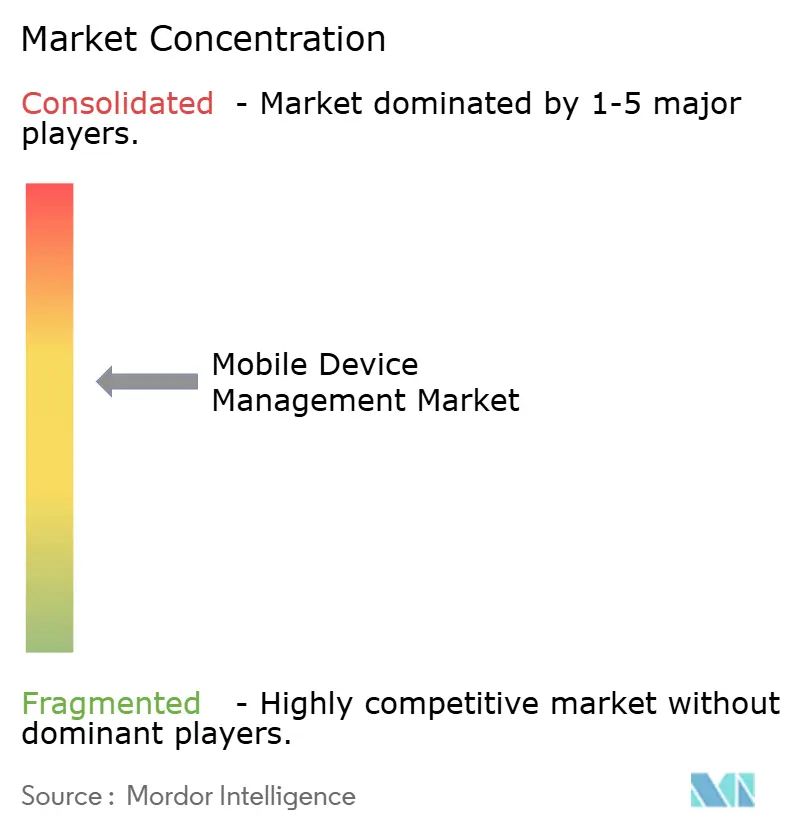
Recent Industry Developments
- March 2025: Jamf agreed to acquire Identity Automation for USD 215 million to strengthen identity lifecycle management in shared-device environments.
- February 2025: Samsung Electronics introduced post-quantum cryptography in Galaxy S25 through Knox Matrix using ML-KEM algorithm.
- January 2025: Jamf signed a five-year Azure partnership, making Jamf Pro available in the Azure Marketplace and integrating Microsoft threat intelligence.
- November 2024: Jamf gained Microsoft Azure IP co-sell top-tier status, enabling customers to draw on Azure budgets for Jamf Pro purchases.
Research Methodology Framework and Report Scope
Market Definitions and Key Coverage
Our study defines the global Mobile Device Management (MDM) market as all commercial-grade software and related subscription services that let IT teams configure, secure, monitor, and wipe smartphones, tablets, laptops, and rugged or IoT endpoints through a central console; it also contains the ancillary support and maintenance fees that accompany these platforms. We, the analysts at Mordor Intelligence, map value only at the software and services layer, not at the underlying device or connectivity tier.
Scope Exclusions: Stand-alone Mobile Threat Defense tools and hardware-only device locks are excluded.
Segmentation Overview
- By Deployment Mode
- On-premise
- Cloud
- By Device Type
- Smartphones and Tablets
- Laptops and Desktops
- Rugged and Wearable Devices
- IoT/IIoT Endpoints
- By End-user Industry
- IT and Telecom
- BFSI
- Healthcare and Life Sciences
- Retail and E-commerce
- Government and Public Sector
- Manufacturing
- Education
- Transportation and Logistics
- By Ownership Model
- Corporate-owned Devices
- BYOD
- COPE (Corporate-Owned, Personally Enabled)
- CYOD (Choose-Your-Own-Device)
- By Geography
- North America
- United States
- Canada
- Mexico
- South America
- Brazil
- Argentina
- Rest of South America
- Europe
- United Kingdom
- Germany
- France
- Italy
- Spain
- Nordics
- Rest of Europe
- Asia-Pacific
- China
- India
- Japan
- South Korea
- ASEAN
- Australia
- New Zealand
- Rest of Asia-Pacific
- Middle East and Africa
- Middle East
- Saudi Arabia
- United Arab Emirates
- Turkey
- Rest of Middle East
- Africa
- South Africa
- Egypt
- Nigeria
- Rest of Africa
- Middle East
- North America
Detailed Research Methodology and Data Validation
Primary Research
Our team conducts semi-structured interviews with CIOs, mobile security architects, channel partners, and managed service providers across North America, Europe, and Asia-Pacific. The conversations validate license pricing ranges, cloud adoption pacing, and real-world device per employee ratios that secondary sources seldom quantify.
Desk Research
We pull baseline data from open-access authorities such as the US Bureau of Labor Statistics, Eurostat, India's TRAI, and trade groups like the GSM Association for installed base, BYOD ratio, and mobility spending trends. Regulatory texts from NIST, GDPR, and HIPAA clarify compliance triggers, while patent analytics from Questel spotlight emerging zero-trust functions. Company 10-Ks, device OEM shipments, and news archives on Dow Jones Factiva enrich vendor-side context. Finally, shipment-level clues from Volza help us cross-check regional device flows. This list is illustrative, not exhaustive.
Market-Sizing & Forecasting
We start with a top-down device pool model that layers enterprise smartphone and laptop installed bases with BYOD penetration, average active seats per MDM tenant, and typical SaaS ARPU. Supplier roll-ups and channel checks act as a bottom-up reasonableness screen before totals are locked. Key market fingerprints used inside the model include: 5G workforce expansion rates, cloud versus on-premise migration shares, average device refresh cycles, and regional compliance spending multipliers. A multivariate regression on these drivers supplies the 2025 to 2030 outlook, and gaps in granular bottom-up inputs are bridged with calibrated adoption curves endorsed by our interview panel.
Data Validation & Update Cycle
Outputs pass two analyst reviews; variances beyond ±5% versus historical trend lines trigger a model rerun. We refresh every twelve months, yet we reopen the file sooner if a material event, such as a major zero-day exploit, alters demand assumptions. Before publication, an analyst performs a last-minute data sweep so clients receive the latest view.
Why Mordor's Mobile Device Management Baseline Commands Reliability
Published figures often diverge because each publisher picks its own scope, pricing lens, and refresh rhythm. We acknowledge those differences up front so users can gauge fit.
Key gap drivers include whether MDM is bundled inside broader Enterprise Mobility or UEM scopes, how aggressively BYOD seats are projected, the mix of perpetual versus SaaS licensing, and currency conversions at varying cut-off dates.
Benchmark comparison
| Market Size | Anonymized source | Primary gap driver |
|---|---|---|
| USD 9.34 Bn (2025) | Mordor Intelligence | |
| USD 15.75 Bn (2025) | Global Consultancy A | Bundles EMM and UEM revenue, high BYOD multipliers |
| USD 9.49 Bn (2025) | Trade Journal B | Relies on sampled vendor disclosures, limited regional scaling |
| USD 13.44 Bn (2025) | Industry Association C | Mixes security hardware with software, older FX rates |
The comparison shows that once differing scopes and input biases are stripped away, Mordor Intelligence offers a balanced, transparent baseline anchored to observable device pools and verifiable license economics, giving decision-makers a dependable starting point.
Key Questions Answered in the Report
What factors are propelling the fast growth of the mobile device management market?
Rising BYOD expectations, cloud-native UEM migrations, cyber-insurance mandates, and 5G-enabled field-service mobilization collectively drive a 30.21% CAGR through 2030.
How large will the mobile device management market size be by 2030?
The market is projected to reach USD 25.04 billion by 2030 according to Mordor Intelligence.
Which region is expanding quickest for mobile device management vendors?
Asia-Pacific leads with a 17.7% CAGR due to 5G build-outs, manufacturing digitization, and mobile-first financial services growth
Why are cyber-insurance policies influencing device-security investments?
Insurers now require demonstrable endpoint encryption, multifactor authentication, and real-time detection, turning MDM deployment into a prerequisite for affordable coverage.
What vertical shows the highest forecast growth?
Healthcare and life sciences top the list at 16.5% CAGR as telehealth and HIPAA compliance expand mobile workloads.
Page last updated on:
